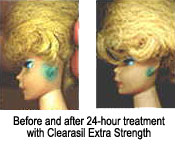Purchases made through my links help support this website, at no additional cost to you. Details.
Do you have a collectible Barbie® doll with “green ear”? Here’s how to remove most of it safely.
I haven’t found any product that removes ALL “green ear” and does it safely. Also, I wrote this article years ago, so there may be better products for this kind of project.

My Barbie / Green Ear Story
I have a great, vintage Barbie® doll in a red swimsuit and her original box, complete with stand.
However, that Barbie had green spots – stains in (not just on) the plastic -where her earrings used to be. It was a developing tragedy as the green spread a little more each year.
Then, I read that Extra Strength Clearasil will remove most of the green discoloration (but sometimes the skin dye, too) by leaching out the color. The active ingredient is Clearasil’s organic peroxide.
The cleaning process can be slow, taking up to a month, sometimes longer. Here’s what I did, and it might work for you.
Disclaimer: This information is provided as a guideline, not as specific advice for your dolls. The author assumes no responsibility for your repair & restoration efforts, and speaks only from personal experience, providing opinions about repairs.
If you have any questions, please consult a qualified doll hospital.
How to use Clearasil to reduce or remove Barbie “green ear”
- Apply the Clearasil with a cotton-tipped swab. (Some choose to use the tip of a toothpick, for extra-precise application.)
- Be sure to apply it to the stain. Avoid any painted areas, or “just fine” skin-colored areas.
- Change the Clearasil every few hours, after each application has dried. (For me, the most dramatic reduction of green appeared after the first application, in about two hours.)
- Keep in mind that the green may get worse before it gets better, as the green inside Barbie’s head is leached out, and becomes visible. (That didn’t happen with my doll.)
And, before you choose one approach to the ‘green ear’ problem, it’s not wise to mix treatments if one doesn’t work. (The plastic can turn brown.)
But remember, most doll restorers say that the green stains cannot be fully removed from most dolls.
Important: I accept no responsibility for results you may have, so please test the Clearasil on a not-important part of any stained doll (or other vinyl item) that you want to clean.
This cleaning tip is strictly for items where the staining is so severe, you have nothing to lose, and safer choices haven’t worked.
Other products that may work as well or better…

Twin Pines of Maine makes “Remove-Zit”, a product with organic peroxide that is intended specifically for treating plastics safely.
Related Link: Tips for Restoring Barbie and Other Plastic Dolls
More info about vintage Barbie, Ken, Francie, and Skipper dolls
If you’d like to learn more about vintage Barbie dolls, this book (shown at right) might be exactly what you seek!
And a search tip…
Remember that the BarbieTM name has been trademarked and is very protected by the Mattel company. If you’re searching for more Barbie-related info, you may have better luck using the phrase “fashion doll.”
Important Legal Information
This website has no connection with the Mattel Corporation.
Advice about fashion dolls, including BarbieTM, is provided as personal opinion. When restoring valuable dolls, always consult a professional before attempting any repair.
The name “Barbie” is a registered trademark of the Mattel Corporation.
Let’s see… did I say enough about trademarks, Barbies and green ear to protect myself..? *LOL*
